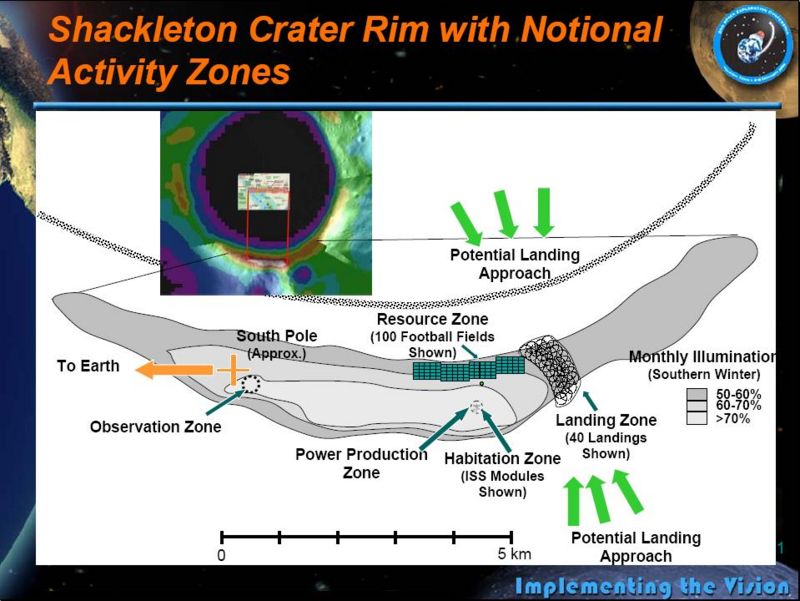Difference between revisions of "NASA Exploration Strategy"
(reformat) |
m (Reverted edits by 195.55.130.44 (Talk); changed back to last version by Jriley) |
||
| (2 intermediate revisions by 2 users not shown) | |||
| Line 28: | Line 28: | ||
Lunarpedia can make an important contribution in most of these areas, but most strongly in Public Engagement and Economic Expansion. | Lunarpedia can make an important contribution in most of these areas, but most strongly in Public Engagement and Economic Expansion. | ||
| − | [[image:ShackletonSite01.jpg]] | + | [[image:ShackletonSite01.jpg|800px]] |
===Luna polar base=== | ===Luna polar base=== | ||
Latest revision as of 00:40, 28 September 2007
NASA Exploration Strategy and Architecture Presentation
In December 4, 2006, Shana Dele, Deputy Administrator of NASA, gave an important presentation providing NASA exploration strategy and architecture for implementing the vision at the 2nd Space Exploration Conference. A number of points in this presentation are important to this wiki.
Presentation Slides
An Adobe .pdf version of the slides can be found at:
NASA Exploration Strategy and Architecture Slides
Themes
Six major themes were identified (Slide 6):
- Human Civilization
- Scientific Knowledge
- Exploration Preparation
- Global Partnerships
- Public Engagement
Lunarpedia can make an important contribution in most of these areas, but most strongly in Public Engagement and Economic Expansion.
Luna polar base
Slide 9 through Slide 16 describes a single lunar base at almost exactly the lunar South Pole.
This site is very similar to the Mount Malapert site described in our stories which is about 125 kilometers Earthward from the South Pole. We must confess that until the Lunar Reconnaissance Observatory (LRO) sends back data, there simply is not enough information to choose the best site for a lunar station. We must wait it out.
What NASA will, and will not, do
The open architecture is discussed in Slide 17. This is a list of the things that NASA is planning to do, and more importantly not planning to do.
NASA plans to provide:
- Lander and ascent vehicle
- EVA system
- CEV and initial surface capability
- Navigation and Communications
- Basic mission support
- Robotic Missions
- LRO - Remote sensing and map development
- Lander
NASA does not plan to provide:
- EVA system
- Long Duration surface suit
- Power, basic and augmented
- Habitation
- Mobility
- Basic rover
- Pressurized rover
- Other; mules, regolith moving, module unloading
- Navigation and Communication
- Augmented
- High bandwidth
- ISRU
- Characterization
- Demos
- Production
- Robotic Missions
- Basic environmental data
- Flight system validation
- Small satellites
- Science rovers
- Instrumentation
- Logistic Resupply
- Specific Capabilities
- Drills, scoops, samples handles, arms
- Logistic rover
- Components
- Sample return
The list of will nots is much longer than the lists of wills.
What does this mean to Lunarpedia
The long list of things that NASA does not plan to do, and does not expect to have the money to do, says that industry and other nations must be major contributors to the back to the Moon effort.
The only way that this will happen is if a large number of people retain a strong vision of success for human beings returning to the Moon and that they take action on that vision. One purpose of Lunarpedia is to build and foster that vision and to support those actions.







